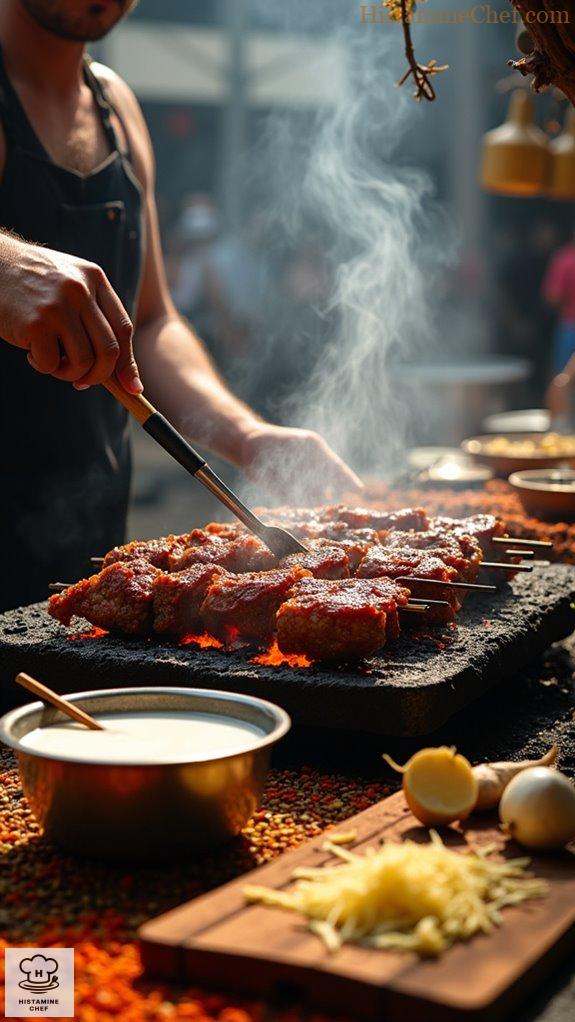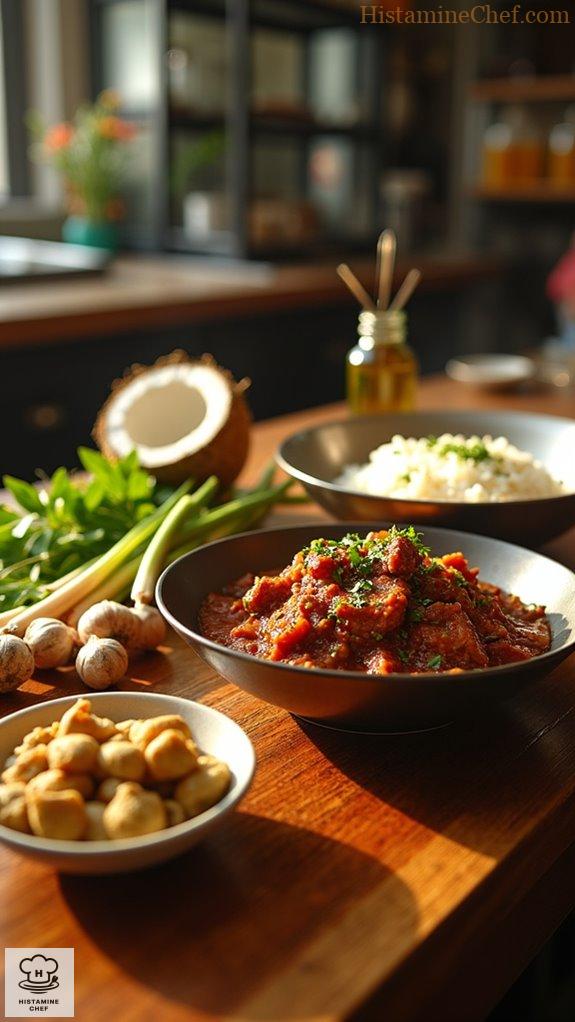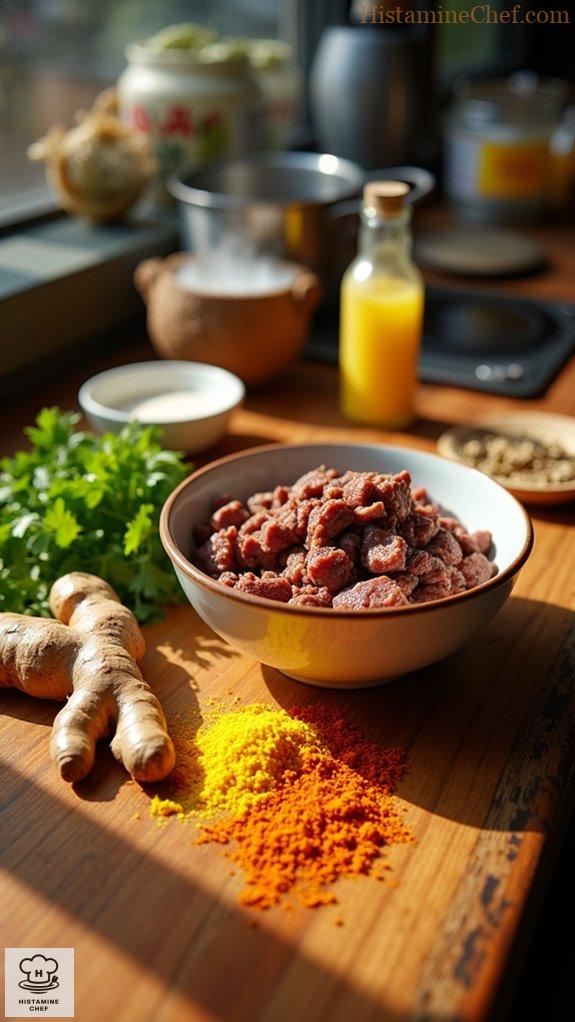If you’ve ever craved the smoky goodness of rendang but worry about histamine woes, you’re in for a treat! Envision tender beef infused with fresh spices, not that aged stuff, grilled over charcoal until it’s crispy perfection. Swapping soy sauce for distilled vinegar? Genius, right? Plus, I promise it’s delicious! So, have you ever thought about street food that won’t make you feel terrible? Stick around, and I’ll share how to whip this low-histamine delight at home!
Vibrant Cultural Hub Jakarta

Jakarta, the bustling capital of Indonesia, is a vibrant cultural hub known for its rich street food culture, which serves as a reflection of the city’s diverse culinary heritage.
The history of street food in Jakarta dates back to its early trading days, where traders and vendors would set up stalls to offer quick and flavorful meals to travelers and workers.
Over the years, this tradition has evolved, with street food becoming an integral part of everyday life for Jakartans. Stalls and food carts dot the city’s bustling streets, offering a wide array of dishes, from the iconic beef rendang to savory satay.
The fusion of local ingredients and spices with influences from Chinese, Indian, and Middle Eastern cuisines has given rise to a dynamic street food scene that not only satisfies hunger but also fosters community and connection among people.
The colorful markets and vibrant street vendors are a testimony to Jakarta’s love for food, making it a must-visit destination for anyone seeking to experience the authentic flavors of Indonesia.
Smoke From Charcoal Grills

Street vendors cook Homemade Rendang Street Food by first marinating the meat in a rich blend of spices and coconut milk.
The marinated meat is then skewered and placed over a charcoal grill, where it’s slow-cooked to perfection. The charcoal adds a smoky flavor that enhances the dish, ensuring the meat becomes tender and absorbs the aromatic spices.
Vendors continuously baste the skewers with leftover marinade, allowing the Rendang to caramelize slightly, creating a beautiful crust. The smoke from the charcoal also envelops the cooking area, drawing in customers with its irresistible scent, making it a delightful street-side experience.
Ingredients Needed:
- 500g fresh beef, cubed
- 200ml coconut milk
- 4 tablespoons grated ginger
- 3 tablespoons grated garlic
- 2 tablespoons galangal, minced
- 2 teaspoons turmeric powder
- 2 tablespoons tamarind paste
- 2 tablespoons sugar
Cooking Steps:
- Marinate beef in spices.
- Skewer marinated beef pieces.
- Prepare charcoal grill for cooking.
- Place skewers over hot charcoal.
- Baste with marinade regularly.
- Cook until tender and caramelized.
- Serve with rice or flatbreads.
- Enjoy the smoky flavors!
Rendang Ingredients and Preparation

To cook Homemade Rendang Street Food at home, start by preparing your base flavoring by grinding fresh ginger, turmeric, and garlic into a paste. Instead of traditional high-histamine meats, opt for fresh chicken or beef (not marinated or smoked).
Sauté the paste in coconut oil until aromatic, then add your choice of cut meat, cooking until browned. Pour in coconut milk and simmer on low heat, stirring occasionally until meat is tender and the liquid reduces to a thick consistency.
For aroma, incorporate fresh herbs like lemongrass and ginger leaves. Serve with allowed sides such as rice cooked in coconut milk for a nourishing meal.
- Use fresh, not preserved ingredients
- Substitute high-histamine meat cuts
- Opt for coconut milk, not dairy
- Avoid soy sauce, use sea salt
- Use fresh herbs, avoid processed ones
- Cook until tender, not overcooked
- Serve with allowed starchy sides
Low Histamine Variation of Rendang

Histamine intolerance can create challenges for those who enjoy street food, as many dishes often include high-histamine ingredients or are prepared in ways that promote histamine formation. This intolerance can lead to uncomfortable symptoms like headaches, digestive issues, and skin reactions, making it crucial to be cautious when choosing foods.
Street food, known for its complex flavors and quick preparation, often relies on ingredients that may trigger histamine responses. Eating street food like Rendang can be problematic for those with histamine intolerance due to the presence of restricted ingredients such as soy sauce and certain spices, which score high on the SIGHI list. This is important since many street food recipes often overlook histamine sensitivity.
In addition, the cooking methods often involve long marination times or additional preservatives, increasing histamine levels in the food, making it harder for sensitive individuals to enjoy safely. This adds another layer of difficulty as many street vendors may not disclose all ingredients or preparation methods.
To create a low histamine variation of homemade Rendang, follow these steps:
- Use freshly cooked beef instead of marinated or processed meats.
- Avoid dried or tinned ingredients; choose fresh vegetables only.
- Replace soy sauce with distilled white vinegar for flavor enhancement.
- Skip using long-fermented spices; opt for fresh herbs only.
- Substitute high histamine oils with extra virgin olive oil or coconut oil.
- Use fresh ginger and turmeric; avoid powdered spices that can be aged.
- Choose sweeteners like maple syrup or honey instead of refined options.
- Confirm all cooking equipment is free from residues of high histamine foods.
- Opt for fresh coconut milk instead of canned versions, which can be aged.
- Cook on a low heat over a short time to minimize histamine buildup.
- Employing smart cooking techniques can help keep the histamine levels in check while preparing your dishes.
Video Summary
Rendang is a traditional Indonesian dish known for its rich, spicy flavors and tender meat. Later in this video, we’ll also explore a home-cooked low histamine version.
Street vendors start by using fresh beef, typically cut into cubes. They marinate the beef with a blend of aromatic spices, including garlic, ginger, turmeric, and lemongrass. Vendors then heat a large pot over medium-high heat.
They add oil to the pot and sear the marinated beef until it browns nicely. Next, coconut milk is poured in, enhancing the dish’s creamy texture. Vendors then add spices like cumin and various chili peppers for heat. Once everything is in, they allow the mixture to simmer for several hours.
This slow cooking makes the meat tender and allows flavors to meld perfectly. By the end, the sauce thickens and deeply coats the beef. The street version is served with fragrant rice, making it a real treat.
For the low histamine home version, start by selecting fresh beef and cutting it into cubes. Substitute garlic and ginger with fresh herbs like basil or cilantro for flavor.
Sear the meat in extra virgin olive oil in a pot over medium heat. Instead of coconut milk, use a mixture of almond milk and fresh basil for creaminess. Avoid spicy ingredients like chili peppers and cumin; instead, use dried coriander and turmeric for warmth.
Cook everything slowly for a couple of hours to achieve tenderness. The meal will resemble the authentic dish in appearance but will be friendlier for your belly.
The final dish is rich, aromatic, and flavorful, perfect for a comforting meal. Click the link in the description for the complete recipe!


Leave a Reply